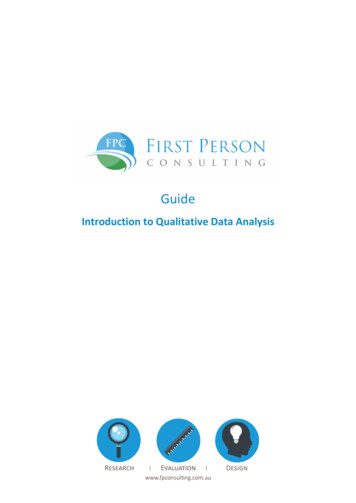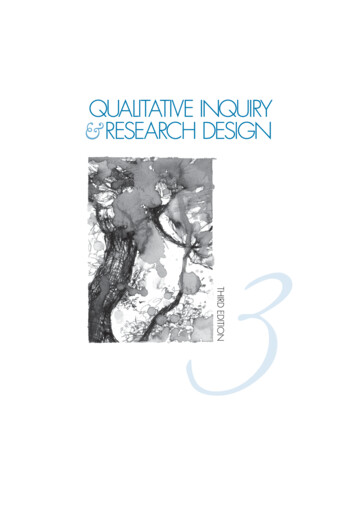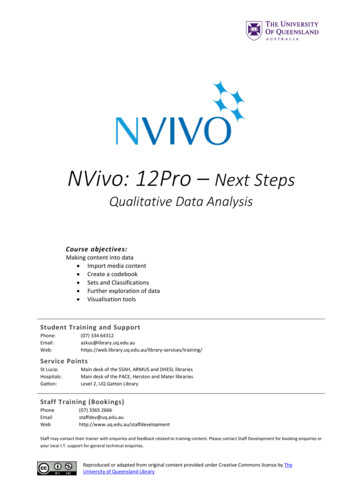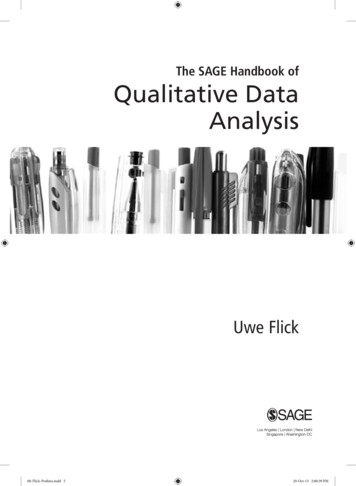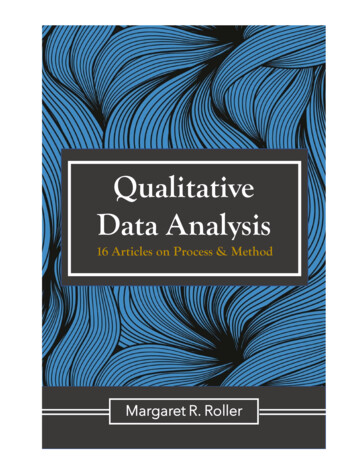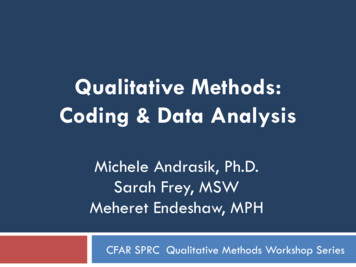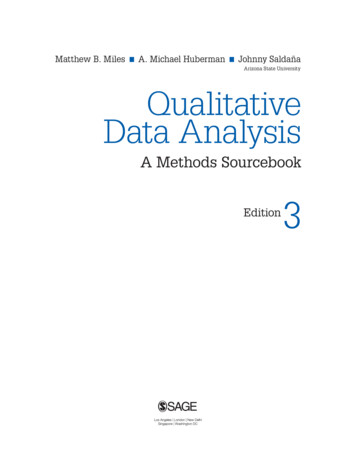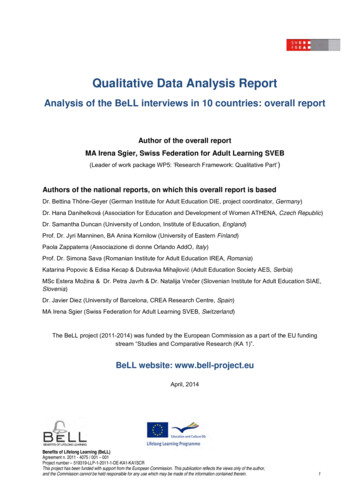
Transcription
Qualitative Data Analysis ReportAnalysis of the BeLL interviews in 10 countries: overall reportAuthor of the overall reportMA Irena Sgier, Swiss Federation for Adult Learning SVEB(Leader of work package WP5: ‘Research Framework: Qualitative Part’)Authors of the national reports, on which this overall report is basedDr. Bettina Thöne-Geyer (German Institute for Adult Education DIE, project coordinator, Germany)Dr. Hana Danihelková (Association for Education and Development of Women ATHENA, Czech Republic)Dr. Samantha Duncan (University of London, Institute of Education, England)Prof. Dr. Jyri Manninen, BA Anina Kornilow (University of Eastern Finland)Paola Zappaterra (Associazione di donne Orlando AddO, Italy)Prof. Dr. Simona Sava (Romanian Institute for Adult Education IREA, Romania)Katarina Popovic & Edisa Kecap & Dubravka Mihajlović (Adult Education Society AES, Serbia)MSc Estera Možina & Dr. Petra Javrh & Dr. Natalija Vrečer (Slovenian Institute for Adult Education SIAE,Slovenia)Dr. Javier Diez (University of Barcelona, CREA Research Centre, Spain)MA Irena Sgier (Swiss Federation for Adult Learning SVEB, Switzerland)The BeLL project (2011-2014) was funded by the European Commission as a part of the EU fundingstream “Studies and Comparative Research (KA 1)”.BeLL website: www.bell-project.euApril, 2014Benefits of Lifelong Learning (BeLL)Agreement n. 2011 - 4075 / 001 – 001Project number – 519319-LLP-1-2011-1-DE-KA1-KA1SCRThis project has been funded with support from the European Commission. This publication reflects the views only of the author,and the Commission cannot be held responsible for any use which may be made of the information contained therein.1
Index1.Introduction . 32.Methodology . 53.Benefits: Overview and Categories. 123.1Sense of purpose in life . 143.2Self-efficacy . 193.3Locus of control . 233.4Social network . 243.5Changes in the educational experience . 273.6Mental well-being . 313.7Physical health / Health behaviour . 343.8Work-related benefits . 353.9Tolerance . 383.10 Trust . 403.11 Civic and social engagement . 403.12 Civic competence . 413.13 Family-related benefits . 433.14 Skills and competences . 444. ‘Most Important Benefits’ . 455. External Criteria . 466. Development of Benefits . 477. Relationship between Benefits . 498. Conclusions . 509. References . 52Appendix . 53-Appendix 1: Interview Guidelines . 54-Appendix 2: Analysis Guidelines . 57-Appendix 3: Code List . 63Benefits of Lifelong Learning (BeLL)Agreement n. 2011 - 4075 / 001 – 001Project number – 519319-LLP-1-2011-1-DE-KA1-KA1SCRThis project has been funded with support from the European Commission. This publication reflects the views only of the author,and the Commission cannot be held responsible for any use which may be made of the information contained therein.2
-Appendix 4: Coding Example (Interpretation workshop 2) . 68-Appendix 5: National Case Schemes . 72-Appendix 6: Additional Description of the Interview Sample . 83Benefits of Lifelong Learning (BeLL)Agreement n. 2011 - 4075 / 001 – 001Project number – 519319-LLP-1-2011-1-DE-KA1-KA1SCRThis project has been funded with support from the European Commission. This publication reflects the views only of the author,and the Commission cannot be held responsible for any use which may be made of the information contained therein.3
IntroductionThis report gives an overview of the qualitative analysis of 82 interviews that were conducted withparticipants of liberal adult education in ten countries within the framework of the European BeLL study.The interviews were analysed by the national research teams in the ten partner countries. This overallreport is based on those national qualitative reports. It follows the same structure as the national reportsand uses statements from all countries to exemplify the results.The aim of the qualitative interview analysis is to illustrate and complement the results of the statisticalanalyses. They are aimed to illustrate and complement the results of the statistical analyses with respect to the benefits and theirindividual dimension (i.e. change of attitudes, self-concept, learning biography, behaviour) and socialdimension (i.e. family life, social networks); find out whether, and if so how, participants of liberal education courses reflect on their learningexperience, whether they are aware of any benefits and able to name them; explore possible connections between the benefits and find observable external benefit criteria; explore the extent to which the emergence and development of benefits depend on course-relatedaspects such as the teacher (personality, expertise, and teaching approaches), the group, the teachingmethods, and so on, as expressed by interviewees based on their experiences; identify ways in which benefits of liberal adult education, according to leaners, emerge and develop inreal-life and biographical contexts, and ways in which they interrelate with them.To answer these questions, we analysed what participants report about their participation in liberal adulteducation courses, about their experiences in liberal adult education courses and about the impact thatparticipation has on their lives. We want to know how participation in liberal adult education affects andchanges participants’ attitudes, self-concepts, learning biographies, and their learning behaviour as well astheir everyday lives, and how participants do assess this. This approach allows us to find out if and howparticipants of liberal adult education courses reflect on their learning experience, if they are aware of anybenefits and able to name them, how they explain or justify the efforts they undertake as learners and howthey define the role adult education plays in their real life contexts. Moreover, this approach allows fordrawing conclusions and hypotheses with regard to possible effects of personal benefits on socialenvironments based on participants’ reports.Additionally, the researches paid attention to country-specific aspects that appear to have an impact on theways in which participants experience and report benefits of learning. Among the research questions thathave been formulated in the course of the research, this is not the core one since BeLL cannot aim atcomparing national education systems. However, awareness of national characteristics is needed to assurean adequate interpretation of the results. These aspects are discussed in the national reports and inlikewise in the overall report and taken into consideration here where appropriate.Benefits of Lifelong Learning (BeLL)Agreement n. 2011 - 4075 / 001 – 001Project number – 519319-LLP-1-2011-1-DE-KA1-KA1SCRThis project has been funded with support from the European Commission. This publication reflects the views only of the author,and the Commission cannot be held responsible for any use which may be made of the information contained therein.4
In the context of the qualitative research report, as in the whole BeLL study, we operationalise ‘benefits’ aseffects and changes for the better in participants’ attitudes, self-concepts, learning biographies and learningbehaviour as well as their everyday lives AND, through this, their social environment (real-life contexts).Below these domains we address the benefit categories that have been developed in the theoretical partsof the study and applied in the quantitative part of the analysis. However, the qualitative part of the analysisillustrates and differentiates the quantitative parts of the study, and it helps to identify ways in whichbenefits of liberal adult education emerge and develop in real-life contexts, and ways in which theyinterrelate with them. Through this, the qualitative part of the study also helps to identify hypotheses andresearch questions for further research.However, on the basis of the qualitative report, we do not attempt to identify different factors that impingeon changes in real-life contexts apart from or accompanying participation. Moreover, we do not seek totrace back the development of benefits in learning processes as such. Findings in this respect would bevery interesting but have to be reserved for further research. Nonetheless, we will present findings onrelevant factors for the development of benefits throughout reported experiences from adult educationcourses, such as the learning relationships of participants with teachers and fellow learners as well aspersonal, thematic learning interests. They also allow for interpretations on the relationships between singlebenefits categories and for participants’ attitudes towards liberal adult education and participation.Chapter 2 of this report gives a summary of the methodological approach used to analyse the interviews.Chapter 3 presents the results for all benefit categories. The remaining chapters give insight into specificissues in connection with the analysis of benefits: most important benefits (chap. 4), external, observablecriteria of benefits (chap. 5), development of benefits within the course context (chap. 6), and relationshipsbetween benefits (chap. 7). Finally, chapter 8 presents some conclusions of the qualitative BeLL research.The interview guidelines and the code list are available in the appendix, as well as the national caseschemes, which give more information about the national samples. All quotes in this report can be identifiedby country and case. GER A, for example, refers to case A from the German sample. The case scheme inthe appendix gives basic information on the respective interviewee.Benefits of Lifelong Learning (BeLL)Agreement n. 2011 - 4075 / 001 – 001Project number – 519319-LLP-1-2011-1-DE-KA1-KA1SCRThis project has been funded with support from the European Commission. This publication reflects the views only of the author,and the Commission cannot be held responsible for any use which may be made of the information contained therein.5
1. MethodologyThis report presents the findings of the qualitative component of BeLL that consists of a series of semistructured interviews with women and men of various age groups and educational levels in all the partnercountries of the project, who attended adult learning courses in the recent past. They were asked to reflectupon their learning experience, their reasons why they engage in adult learning activities, the benefits (ifany) they draw from these activities, and more generally on how they see the role of adult education in theireveryday life.Research designThe qualitative component of BeLL is to be understood in the context of an overall sequential (quantitativefollowed by qualitative) mixed-methods research design (Kelle 2006: 08) consisting of a large-scale survey1in each of the ten partner countries of the project, and a subsequent series of 82 qualitative interviewswith selected respondents of the survey. The rationale behind the qualitative component of the study was toprovide more in-depth and more contextualised insights into how people perceive the outcomes andbenefits (effects and changes) of participating in adult learning courses. Whereas the survey providedinformation about the degree to which adult learning courses are seen as beneficial and relevant by theparticipating population, the qualitative interviews provide “rich” information about what such coursesactually mean to them, how the courses in which they participated fitted into their life history, what (preciseand specific) reasons led them to participating and how the benefits developed etc. In terms of researchstrategy, the qualitative interviews aimed at complementing the survey data by rich and unstandardiseddata and thereby obtaining an overall richer and more accurate picture of the participants in adult learning2courses ). Incidentally, the interviews also allowed to grasp culturally different understandings of adultlearning. This is particularly useful in the context of a comparative study that covers countries where adultlearning has very different histories and traditions.The interview data are analytically treated as one single data body that is analysed transversally along a setof common dimensions.Data collectionThe qualitative part of BeLL (Workpackage 5, WP 5) was carried out in all ten partner countries after thesurvey. Besides a series of closed survey questions, the survey questionnaire also contained three openquestions, two of which asking to name outcomes and benefits (effects and changes) and one asking therespondents to describe the outcomes and effects (immediate or long term) of their course participation.The third open question asked the respondents to give examples to illustrate the development of theirbenefits in relation to certain course related aspects like trainer, methods or group. The results were pre-1Czech Republic, England, Finland, Germany, Italy, Romania, Serbia, Slovenia, Spain, Switzerland.2In Hammersley's terminology, we can say that we applied a strategy of “triangulation as validity-checking” and“triangulation as seeking complementary information” (Hammersley 2008).Benefits of Lifelong Learning (BeLL)Agreement n. 2011 - 4075 / 001 – 001Project number – 519319-LLP-1-2011-1-DE-KA1-KA1SCRThis project has been funded with support from the European Commission. This publication reflects the views only of the author,and the Commission cannot be held responsible for any use which may be made of the information contained therein.6
analysed (themes and frequency tables). On this basis, we then developed the interview questions and,3subsequently, adapted the code system for the qualitative analysis of the interviews (cf. below).The survey questionnaire included a question asking whether the respondent would be willing to becontacted for a longer interview at some later point. Of the total 8’646 respondents to the national surveys,27 per cent accepted to be contacted. Of these, 82 people were finally interviews some months after thesurvey (8 respondents per country, except for Spain where 10 people were recruited for an interview). Thenational research teams were given the instruction to purposefully select a group of respondents thatreflected the diversity of their national sample, namely in terms of gender, age, level of education and the4number of courses that the person had taken in the 12 months preceding the survey . The different nationalteams made slightly different choices, however the overall resulting sample of interviewees was overallquite similar in structure to the national survey samples, especially in terms of gender (about two-thirdswomen) and age (c.f. appendix). Compared to the survey sample, the qualitative sample had a higherproportion of “active” learners (i.e. people who had attended more than one adult learning course over the12 months preceding the survey) and a somewhat lower proportion of respondents with low professionalqualifications (see below for details).The final composition of the group of interviewees was not completely under the control of the researchteams, as many of the respondents to the survey who had stated their readiness to be interviewed finallydid not make themselves available after all (some did not respond at all to the e-mail inviting them for aninterview, whereas others declined the invitation). In some countries (Germany for example), findingenough interviewees was a real challenge. In other countries (Switzerland for example) finding a sufficientnumber of respondents was not a problem, but certain categories of potential respondents were particularly5hard to mobilise . Where a purposive sampling strategy was not entirely successful, the national teams6pragmatically resorted to a strategy of opportunistic samplingThe interviews were done in the months following the survey, either face-to-face or over the phone, andlasted between 20 and 45 minutes. All interviews were audio-taped.The topic guide for the thematic interviews was developed through a collaborative process under theresponsibility of the work package leader: the latter developed a first version of the interview guide, thendiscussed it with selected partners first, before submitting a draft version to all national teams for feedback(via google groups). On the basis of the feedback from all partners, the work package leader then finalisedthe definitive topic guide, which each national team translated back to their national language(s). In parallelwith this consultative process, the leader of the qualitative work package also pre-tested a version of thetopic guide (two pilot interviews in Switzerland), which led to some minor adjustments of the guide.3The open survey questions, their purpose, and construction as well as the results of this part of the study are treatedin depth in the context of other parts of reports on the BeLL study.4Our overall sampling strategy could be described as a purposive sampling (Luborsky & Rubinstein 1995; see alsoElam et al. 2003).5In Switzerland for example, young people did not react to our mails.6Opportunistic in the sense of taking the opportunities that arise (e.g. interviewing the respondents willing to respond)(see also Ritchie & Lewis & Elam 2003 and Luborsky & Rubinstein 1995).Benefits of Lifelong Learning (BeLL)Agreement n. 2011 - 4075 / 001 – 001Project number – 519319-LLP-1-2011-1-DE-KA1-KA1SCRThis project has been funded with support from the European Commission. This publication reflects the views only of the author,and the Commission cannot be held responsible for any use which may be made of the information contained therein.7
The final topic guide had the following structure: a first introductory section in which the interviewee wasasked about his/her participation in adult learning courses over the 12 months preceding the interview(what courses, why, in what professional context etc.). In the second section the respondents were askedto elaborate on the benefits they thought they gained in participating in these courses (personal, but alsocareer related benefits, social networks etc.). In the third section the respondents were then invited tospeak about how these benefits “came about”, e.g. what elements contributed to making these coursesbeneficial to them (such as: the quality of the trainer, the learning methods, the other participants, etc.). Inthe final part of the interview, the respondents were asked to reflect more synthetically on their experiences(their overall assessment of their learning experience etc.). The topic guide contained the complete set ofbenefits from the survey - that is, the benefits mentioned in the survey questionnaire as well as additionalbenefits that were found in the analysis of the open questions (see appendix for the full topic guide).The interviews followed the logic of the semi-structured interview (Arksey & Knight 1999): the topic guideserved as a general guideline, but the question wording and sequence could be handled flexibly by theinterviewers. Additional questions could be asked as necessary. More generally, the interviewer had aleeway to add or reformulate questions, or drop questions (if an answer had already been providedspontaneously, for instance). Overall the interviewers mostly respected the general structure of theinterview guide.All interviews were carried out and fully transcribed by the members of the national teams in the national7language(s) of each country . Subsequently, selected extracts of the interview materials were translatedinto English (see next section).The resulting data body comprises approximately 1200 pages of interview transcripts (between 10 and 20pages per interview).Research ethicsAll interviewees gave their explicit consent to being interviewed and to being audio-recorded. They wereinformed of the context of the study and the use that would be made of their data.The interview data were anonymised in such a way as to make sure neither the respondents themselvesnor other people they are referring to in the interview (such as trainers, adult learning institutions, etc.)cannot be identified. The interview transcripts contain no information allowing to link back the interview datato the survey responses of the interviewee.To further preserve the anonymity of the interviewees, the list with the full demographic characteristics ofour interviewees (such as place of residence, name of course providers, employment status, etc.) is notintegrated to the present report. Only a simplified list is added to the report itself.Data analysisThe interview data were analysed on the basis of a systematic coding, following the approach suggested bySaldaña (2012). This type of analysis consists of a systematic coding (breaking down) of data according to7In Switzerland, interviews were done in German.Benefits of Lifelong Learning (BeLL)Agreement n. 2011 - 4075 / 001 – 001Project number – 519319-LLP-1-2011-1-DE-KA1-KA1SCRThis project has been funded with support from the European Commission. This publication reflects the views only of the author,and the Commission cannot be held responsible for any use which may be made of the information contained therein.8
8a code list (or code system ), in such a way as to identify (practically and theoretically) relevant patterns.The coded segments are then grouped and synthesised ‘up’ into (more general) categories, which in turnget linked to more general themes and (theoretical) concepts.Code system and test codingThe analysis was carried out stage-wise, using a combination of deductive and inductive coding (also called"hybrid" coding, cf. Fereday & Muir-Cochrane 2006). The code system (and the categories and themes thatwere developed on the basis of the coding process) was developed gradually and collaboratively. Theconcepts (the benefit categories named above that were used, operationalised and expaned in the BeLL9study) to which the codes, categories and themes finally were linked were given from the start anddeveloped on theoretical grounds (cf. overall final report).The final code system had the following (main) categories (cf. Appendix 2 for the full code system): Benefits Development of benefits Relationships between benefits Reasons for participation External criteria.10Each of these categories had a number of subcategories and codes . The most important categories were"benefits", “development of benefits” and “relationship between benefits”. The categories "reasons forparticipation" and "external criteria" were less central and served the purpose of collection additionalinformation that could help interpreting the information coded under the main three categories.This code system was taken from the qualitative analysis of open survey questions and further developedin a stage-wise collaborative process, in the form of various (virtual or real) workshops whose aims were totest for the applicability, common understanding and adequacy of the code system.The starting points were the set of concepts that had been developed earlier for the BeLL survey and theset of codes that had been developed through qualitative content analysis of the open questions in thesurvey (cf. Survey Report and Overall Research Report). The leader of WP5 first instructed all nationalteams to run a first test coding (with the initial code system) on an interview by the British team. She11collected all test codings, discussed the outcome in a small working group that identified a series of8Codes, in Saldaña's terminology, are short words or phrases ("tags") that are more general than the coded textsegment itself, but that remain close to the original text9Key concepts are for example: Locus of control, self-efficacy, tolerance, trust, social network, sense of purpose in life,civic competence, etc. (see Glossary in the appendix).10The category "benefits" for example had 17 subcategories and 80 codes, of which 11 inductive codes.11The leader of WP5 and two members of the German and Finnish teams.Benefits of Lifelong Learning (BeLL)Agreement n. 2011 - 4075 / 001 – 001Project number – 519319-LLP-1-2011-1-DE-KA1-KA1SCRThis project has been funded with support from the European Commission. This publication reflects the views only of the author,and the Commission cannot be held responsible for any use which may be made of the information contained therein.9
12issues to submit to all national teams for discussion (disagreements over the interpretation of certaincodes or categories, for instance, or suggestions for the inclusion of new codes, or for the renaming of13codes). On this basis, the code system was adjusted and complemented , and guidelines for a second testcoding elaborated.The second test coding was done by all national teams on a second interview done by the British team,14plus on two national interviews (in original language) . Like for the first test, the coded materials (inEnglish) were collected, issues to be discussed identified by a sub-working group, and then submitted to15collective discussion to all national teams. On this basis, the coding system was again adapted , and16actually more or less "stabilised" . It was also decided that the national teams could add additional codes,meant for use on their national data only, in cases where the common code system did not allow to capture17some significant specificity of their data .Full codingOn the basis of this second test coding, the guidelines for analysis were again revised (see Appendix). Onthese grounds, all national teams were then instructed to code all their national interviews (in originallanguage). At least two people per national team were involved in this coding: a main coder, and a second18coder who systematically counter-checked the coding . Disagreements over the coding were discussedbetween the main and the second coder, and where necessary, submitted to all national teams forcollective discussion (via google groups). Where major difficulties arose in the application of the codesystem, the national teams were asked to translate the "problematic" passages into English and submit19them to a collective discussion .Throughout the coding phase (starting with the first test coding), analytic memos and google groupsdiscussions were used to discuss coding divergences and open questions and keep track of assumptionsor hints for the interpretation of the data. In each national research team, all codings were carried out byone researcher and counter-checked by a second researcher to assure the robustness and internal validityof the coding. Apart from two research teams who used coding software (Maxqda and Atlas.ti), all otherresearch teams coded their data manually (see coding example in the Appendix).12Many of these discussions took place over google groups; some in person.13The main changes concerned the codes; the main categories and subcategories remained unchanged.14Interpretation workshop 1, see Appendix xx.15As at the previous stage, the changes concerned the level of codes only; the main categories and subcategoriesremained unchanged.16Only very minor changes were made to the code system after that.17The elements coded with country-specific codes only are not reported in this report, but only in the nationalqualitative reports.18The data were not double-coded.19Most issues could be resolved without modifying the code system as such.Benefits of Lifelong Learning (BeLL)Agreement n. 2011 - 4075 / 001 – 001Project number – 519319-LLP-1-2011-1-DE-KA1-KA1SCRThis project has been funded with support from the European Commission. This publication reflects the views only of the author,and the Commission cannot be held responsible for any use which may be made of the information contained therein.10
Throughout the process, the team leader of the qualitative workpackage (in co-operation with the projectleader) of the project provided the national teams with standardised supporting materials, namely (seeattachment):-Analysis guidelines for each of the three interpret
Qualitative Data Analysis Report . Analysis of the BeLL interviews in 10 countries: overall report . Author of the overall report . MA Irena Sgier, Swiss Federation for Adult Learning SVEB (Leader of work package WP5: ‘Research Framework: Qualitative Part’) Authors of th

